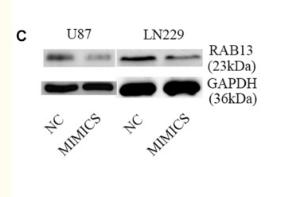RAB13 Antibody - #DF9813
| Product: | RAB13 Antibody |
| Catalog: | DF9813 |
| Description: | Rabbit polyclonal antibody to RAB13 |
| Application: | WB |
| Cited expt.: | WB |
| Reactivity: | Human, Mouse, Rat |
| Prediction: | Pig, Zebrafish, Bovine, Horse, Sheep, Rabbit, Dog, Xenopus |
| Mol.Wt.: | 23 kDa; 23kD(Calculated). |
| Uniprot: | P51153 |
| RRID: | AB_2843007 |
Related Downloads
Protocols
Product Info
*The optimal dilutions should be determined by the end user.
*Tips:
WB: For western blot detection of denatured protein samples. IHC: For immunohistochemical detection of paraffin sections (IHC-p) or frozen sections (IHC-f) of tissue samples. IF/ICC: For immunofluorescence detection of cell samples. ELISA(peptide): For ELISA detection of antigenic peptide.
Cite Format: Affinity Biosciences Cat# DF9813, RRID:AB_2843007.
Fold/Unfold
Cell growth-inhibiting gene 4 protein; GIG4; Growth inhibiting gene 4 protein; RAB13; RAB13 member RAS oncogene family; RAB13_HUMAN; RAS associated protein RAB13; Ras related protein Rab13; Ras-related protein Rab-13;
Immunogens
A synthesized peptide derived from human RAB13, corresponding to a region within the internal amino acids.
Detected in several types of epithelia, including intestine, kidney, liver and in endothelial cells.
- P51153 RAB13_HUMAN:
- Protein BLAST With
- NCBI/
- ExPASy/
- Uniprot
MAKAYDHLFKLLLIGDSGVGKTCLIIRFAEDNFNNTYISTIGIDFKIRTVDIEGKKIKLQVWDTAGQERFKTITTAYYRGAMGIILVYDITDEKSFENIQNWMKSIKENASAGVERLLLGNKCDMEAKRKVQKEQADKLAREHGIRFFETSAKSSMNVDEAFSSLARDILLKSGGRRSGNGNKPPSTDLKTCDKKNTNKCSLG
Predictions
Score>80(red) has high confidence and is suggested to be used for WB detection. *The prediction model is mainly based on the alignment of immunogen sequences, the results are for reference only, not as the basis of quality assurance.
High(score>80) Medium(80>score>50) Low(score<50) No confidence
Research Backgrounds
The small GTPases Rab are key regulators of intracellular membrane trafficking, from the formation of transport vesicles to their fusion with membranes. Rabs cycle between an inactive GDP-bound form and an active GTP-bound form that is able to recruit to membranes different sets of downstream effectors directly responsible for vesicle formation, movement, tethering and fusion. That Rab is involved in endocytic recycling and regulates the transport to the plasma membrane of transmembrane proteins like the tight junction protein OCLN/occludin. Thereby, it regulates the assembly and the activity of tight junctions. Moreover, it may also regulate tight junction assembly by activating the PKA signaling pathway and by reorganizing the actin cytoskeleton through the activation of the downstream effectors PRKACA and MICALL2 respectively. Through its role in tight junction assembly, may play a role in the establishment of Sertoli cell barrier. Plays also a role in angiogenesis through regulation of endothelial cells chemotaxis. Also involved in neurite outgrowth. Has also been proposed to play a role in post-Golgi membrane trafficking from the TGN to the recycling endosome. Finally, it has been involved in insulin-induced transport to the plasma membrane of the glucose transporter GLUT4 and therefore may play a role in glucose homeostasis.
Cell membrane>Lipid-anchor>Cytoplasmic side. Cytoplasmic vesicle membrane>Lipid-anchor>Cytoplasmic side. Cell junction>Tight junction. Golgi apparatus>trans-Golgi network membrane. Recycling endosome membrane. Cell projection>Lamellipodium.
Note: Tight junctions or associated with vesicles scattered throughout the cytoplasm in cells lacking tight junctions (PubMed:8294494). Relocalizes to the leading edge of lamellipodia in migrating endothelial cells (By similarity).
Detected in several types of epithelia, including intestine, kidney, liver and in endothelial cells.
Belongs to the small GTPase superfamily. Rab family.
Research Fields
· Cellular Processes > Cellular community - eukaryotes > Tight junction. (View pathway)
References
Application: WB Species: Human Sample: LN229 and U87 glioma cell
Restrictive clause
Affinity Biosciences tests all products strictly. Citations are provided as a resource for additional applications that have not been validated by Affinity Biosciences. Please choose the appropriate format for each application and consult Materials and Methods sections for additional details about the use of any product in these publications.
For Research Use Only.
Not for use in diagnostic or therapeutic procedures. Not for resale. Not for distribution without written consent. Affinity Biosciences will not be held responsible for patent infringement or other violations that may occur with the use of our products. Affinity Biosciences, Affinity Biosciences Logo and all other trademarks are the property of Affinity Biosciences LTD.
